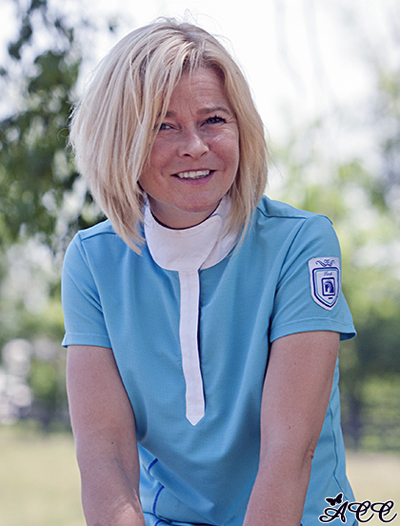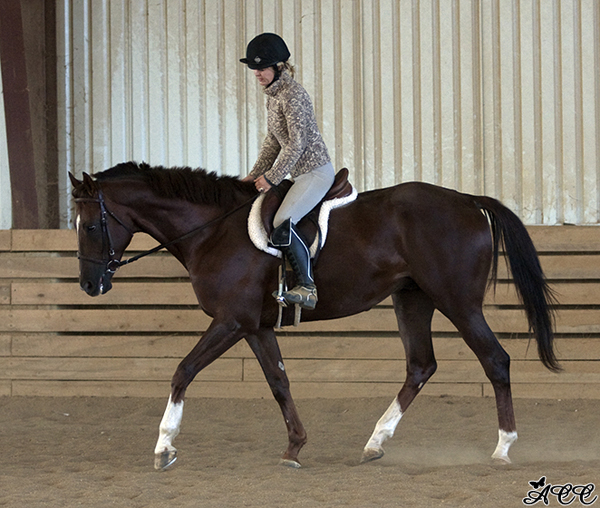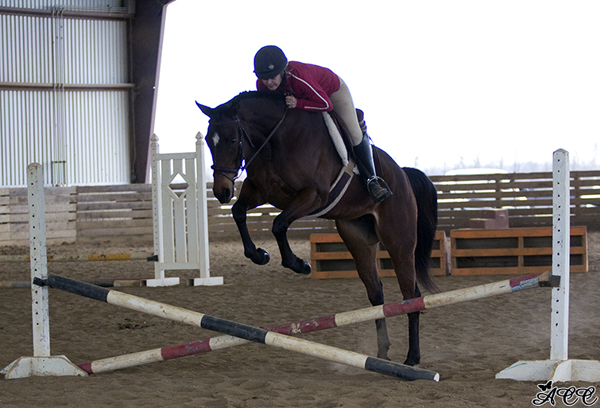Lisa Molloy– OTTB Trainer with Ex-Racehorse Adoption Program
Lisa Molloy shares her story of how she became involved with horses and the retraining of OTTB's (off-the-track-Thoroughbreds) through New Vocations. She has a high success rate of placing many of her retrained ex-racehorses into the right adoptive homes. Learn what it's like in Lisa's daily life with re-schooling, rehabilitating and the adoption process of her OTTB trainees.

Lisa Molloy / Photo by Audrey Crosby McLellan
Raina Paucar for Equitrekking: Lisa, please share with us your background with horses.
Lisa Molloy: I have been lucky and privileged to work with some of the greatest horses and trainers in both this country and my own native England over the past 24 years since leaving school. I started riding ponies at the age of four and frequently competed at local shows and gymkhanas.
Having graduated with a degree in Thoroughbred Racehorse Management along with British Horse Society qualifications, I was fortunate to work for legendary steeplechase trainer Jimmy Fitzgerald. I even galloped two-time Scottish Grand National winner, Androma and Cesarewitch winner, Kayudee. I held the position of assistant manager at Littleton Stud, home to two-time Cartier Horse of the Year, Lochsong, and was second man at the historic Side Hill Stud in Newmarket.
During the early 90's, I attended Colorado State University. I was doing several short courses in equine reproduction, followed by more than ten years working for the famed Bob Perry Quarter Horse Ranch in Valley View, TX. Home to Hall of Fame Quarter Horse stallions Zippo Pine Bar and Zips Chocolate Chip, there I foaled out about one-hundred mares a season. Since 2009, I have been passionately involved in the retraining and adoption of Thoroughbreds in the New Vocations program.
Equitrekking: How did you get involved with Thoroughbred ex-racehorses?
Lisa Molloy: Although I’ve always been around ex-racehorses, my very personal journey with them began after my husband deployed to Afghanistan. Alone with a baby and living in a new state, I decided to get up and do something positive. I adopted my first OTTB named The Slewer from the Thoroughbred Retirement Foundation. As it turns out, I needed him as much as he needed me–– he had been placed in multiple adoptive homes over the years and craved some stability. I needed a distraction from the stress of my husband's deployment overseas.
I bought a second ex-racehorse and was then approached by New Vocations with an intriguing offer to train and place three horses for them in a pilot scheme for a new facility in Lexington, Kentucky. Three years and three-hundred adopted horses later, my average number of horses in training is fifteen. I’ve added more horses to my own herd, all New Vocations horses that were going to be hard to place and the rest is history, as they say!

Lisa working OTTB Atticus under saddle / Photo by Audrey Crosby McLellan
Equitrekking: How has it been to work with New Vocations?
Lisa Molloy: It’s been a rewarding and immensely fulfilling experience. Every time a truck rolls in, it’s like Christmas Day with a new present arriving, each with its own personality and story to tell. I’ve been blessed with a job that brings me into daily contact with so many wonderful horses and people.
The program could not be so hugely successful without the amazing adopters that open their homes and hearts to these animals. When they take our diamonds in the rough and turn them into polished gems in the dressage ring, jumping stadium or as a loyal friend and lifetime companion, the satisfaction is enormous.
I work with a very cohesive team, from my photographer, my farrier, my chiropractor and my vet–– each person is highly instrumental in the transitioning and retraining process of the horses, which plays a unique part. Ultimately, it all comes together and results in a successful adoption for the horse.
Equitrekking: What is your typical day like with the horses?
Lisa Molloy: I do morning checks at 8am after the staff have fed and made sure everyone has eaten, legs are cold and tight and then half of the horses go for turnout time. I usually have between ten to fifteen New Vocations horses at any one time, in addition to private clients, boarders and my own horses.
Turnout varies from private (for those most recently off-the-track) to a small group for those just transitioning and large group turnout for those comfortable in more social situations. I ride the ones that have not been turned out yet, and I try to mix it up with flat work, poles and cross rails in the arena and trail riding around the eighty acre farm. I try to answer calls and emails between rides and then I swap out the horses in the afternoon–– those ridden in the morning get turned out and those that have been out then get ridden.
Of course, I have to be flexible–– vet evaluations of new horses, farrier, chiropractor and the weather can all change my planned schedule at any moment. Horses are then checked over every afternoon for any nicks or scrapes, loose shoes or any other issue that they may have incurred while out playing and then it’s feed time at 4pm.
The horses are hayed, watered and checked for the final time at 9pm. Work continues well into the night. Every night I’m responding to inquiries about horses for adoption through email and phone. There are contracts to copy and fax, videos and photos of available horses to upload to various social media–– even away from the barn, there is a lot to do behind the scenes to make a successful adoption happen.
Equitrekking: What is the most challenging aspect of re-schooling an ex-racehorse?
Lisa Molloy: The riding for me is not so much of the issue. The key to being successful with an ex-racehorse is finding the right turnout situation for each individual horse along with a good feed program that incorporates; low sugar, low starch, high fiber and a high fat diet.
Although herd animals, some have not been turned out with other horses since they were yearlings. Finding them a suitable pasture buddy where they are comfortable and relaxed, is like hitting the reset button in their head. The rest seems to just fall in place. Once that happens, there is a direct correlation between a horse that is happy at rest to a happy horse under saddle.
One of the biggest challenges under saddle is teaching the horse to get off its forehand and to stop balancing itself by placing weight on my hands. I like to teach them all to go long and low on a loose rein to start. Relaxation at the poll and through the back are essential and then as the horse develops more muscle tone and balance, it will gradually start seeking the bit and start to bring its hocks under itself with impulsion.
Too many people are in a rush to get their horse “into a frame” with none of the fundamental basics of true collection, which results in a false frame and an unhappy horse.

Lisa and her ex-racehorse Pentagon / Photo by Audrey Crosby McLellan
Equitekking: What was your most memorable ride on an ex-racehorse?
Lisa Molloy: There have been so many that I have thoroughly enjoyed. It’s hard to pick just one, but Pentagon is up there as one of my most memorable rides. He was donated to New Vocations and came with a fearsome reputation. He was known to dump his riders on a regular basis at the track and was also difficult to handle on the ground. Standing at 17.1 hands at just 4 years old–– he was a big horse to get on the wrong side of and liked to intimidate people. I started riding him once he had settled in and we had a feel for each other immediately. Knowing that he may be difficult to place with his prior history, I signed the papers and adopted him myself.
With just three weeks of riding on him, I took him to the inaugural Thoroughbred Horse Show Association’s show at the Kentucky Horse Park. I entered him in the cross rails division. I had a feeling it was going to go either really well or would be very bad. I wondered in the days leading up to the show if maybe I had bitten off more than I could chew.
He took everything in his stride, from the planters, flower boxes, crowds, sights and smells. He gave me a tremendous ride over fences, but the division flat class was the highlight for me. He rode like a pro, and we walked away with two 4th place finishes and a 3rd in class sizes of 12. I was elated! I could not have been more proud if he’d have won an Olympic medal. He rose to the occasion and went above and beyond anything I had envisioned.
Equitrekking: What's an adoption story that you will always remember?
Lisa Molloy: The story of Dick G is one that will never fail to bring tears to my eyes. Dick retired at the age of 7 with 22 starts and around $30,000 in earnings. He was a big horse that reminded me of steeplechasers back in England. He was a sensible, level headed type of guy that loved to trail ride.
An approved adopter named Grace contacted me and scheduled an appointment to come view him. When she arrived, she asked if she could bring her two children who have disabilities into the barn to see him. Timmy and Bitsey were both in wheelchairs, and I must admit, I was apprehensive about how Dick would behave in the presence of wheelchairs.
What happened next made the hair on my arms stand on end and tears prick my eyes–– Dick, all 16.3 hands of him towered over those small children and then started gently snuggling Timmy. What began as snuggling and nosing became licking. To this day, I swear that old horse knew he had to be careful and gentle with those children. t was one of the most emotional and touching things that I have ever seen.
Dick went home with Grace and the children and became known as Teddy. Timmy stays in his wheelchair outside of Teddy’s stall at the barn. Teddy has become very protective of his new owner. I cannot adequately describe in words what we all witnessed that day, but I’m glad I was there to see it. Winston Churchill said, “There’s something about the outside of a horse that is good for the inside of a man.”

Lisa riding Leaps, Jumps and Turns / Photo by Audrey Crosby McLellan
Equitrekking: What makes OTTB’s great adoptees?
Lisa Molloy: OTTB’s have all the attributes that make them as versatile as the American Quarter Horse. There is nothing that they can’t do if they understand what is being asked of them. Anyone can see and appreciate the majestic nature of a Thoroughbred, be it running in the pasture or running on the track. To truly know one and share a personal relationship with one is a wonderful experience. These horses have so much more to offer once their racing days are over.
Equitrekking: Any advice for people who are considering adopting an OTTB?
Lisa Molloy: In the movies, a horse forms a tremendous bond with a small child. A retired two-year old Thoroughbred that has just been gelded is unlikely to have watched that scene and would not be appropriate for a child.
The boarding, feeding, shoeing, routine vet work and any emergency vet calls all come at a price. It’s not cheap and can quickly eat into any budget. Have realistic expectations of what is involved in owning and training an ex-racehorse. Most are not suitable as child mounts, for novice riders or first time horse owners.
Although an ex-racehorse is broke to ride, it should be considered green broke in terms of general riding. Typically horses available through adoption programs are not finished horses and will require additional training and re-schooling. You get out what you put in. To be successful at retraining your new horse, it requires consistency and time on a daily basis. Be aware and prepared for the constraints that this will put on your time. A finished horse does not just happen overnight.
Equitrekking: What do you think is the most difficult issue for Thoroughbreds right now in America?
Lisa Molloy: I think there are several critical issues facing all Thoroughbreds at the moment; the rate of catastrophic breakdowns at tracks across the country, the perceived failure of racing to police itself and protect the horses, the number of ex-racehorses that are still entering the slaughter house pipeline and being shipped out of the country under inhumane conditions to be slaughtered and processed for meat.

Lisa with one of her OTTB trainees / Photo by Audrey Crosby McLellan
Equitrekking: Is there anything else you’d like to share about OTTB's?
Lisa Molloy: One of the leading misconceptions about Thoroughbreds is that they are all wild, crazy and hard to handle. Just like people, they all come with their own individual character traits and personalities–– no two horses are the same.
Treated on an individual basis with socialized turnout, correct balanced feeding and a regular training program, some can even be described as downright lazy. 95% of a horse’s issues are manmade and are created by the handler/ rider. With correct transitioning from the track, Thoroughbreds are one of the kindest, smartest, most versatile breeds in the world, and I couldn’t imagine life without them.
Lisa's resources on ex-racehorse adoption:
About the Author: Raina Paucar is an adventure loving equestrian and retired female jockey. She likes to ride and compete in many disciplines, explore new places, read great books, gadget hoard, play games, take pictures and write. She currently exercises racehorses and works with her own off-the-track-Thoroughbred (OTTB). Her career in media focuses on equestrian lifestyle. You can add her to your Google+ circles, subscribe on Facebook and follow on Twitter.




